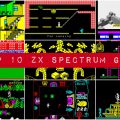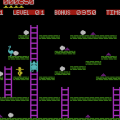In the golden age of 8-bit computers, the Stamper brothers, Tim and Chris, carved their niche with innovative and action-packed titles for the ZX Spectrum. One such game, released in 1984, was Sabre Wulf, a unique adventure game that captured the imagination of gamers with its exploration, combat, and a touch of mystery. This article delves into the world of Sabre Wulf, exploring its origins, variants, critical reception, and the gameplay that made it a classic.

Exploring the Jungle: Unveiling the Gameplay
Sabre Wulf placed players in the role of Sabreman, tasked with finding 4 pieces of a mysterious amulet, in order to pass the titular Sabre Wulf and escape the Jungle. The gameplay revolved around:
- Maze Exploration: Sabreman navigated a vast, 256-screen jungle maze filled with obstacles, enemies, and hidden paths. The game used a “flick screen” mechanic, so effective in earlier game Atic Atac, where the background was static and the screen would “flick” to the next when the player approached the edge.
- Combat: Using his trusty saber, Sabreman fought off various foes like bats, snakes, and spiders. Strategic use of the saber and careful timing were crucial for success. Some enemies could not be killed so had to be dodged or completely avoided.
- Power-Ups: Scattered throughout the maze were orchids with random effects, some beneficial and some detrimental, adding an element of surprise and risk-reward.
- Treasure: Score extra points by finding treasure, as well as gaining extra lives.
- Amulets: The key to escaping the jungle lay in collecting four hidden amulet pieces scattered across the maze. Oh and finding the exit, a centrally located cave guarded by a mysterious native.
Sabre Wulf presented a unique blend of exploration, combat, and puzzle-solving, offering a satisfyingly, if a little repetitive, open-ended experience.

Sabre Wulf: Home Computer Variants
The game wasn’t confined to the ZX Spectrum. Here’s a look at its adaptations for other platforms:
- Acorn BBC Micro (1984): A faithful port retaining the core gameplay but with slight graphical tweaks. The primary benefit over the Spectrum version was the avoidance of the colour clash that plagued the Sinclair machines graphics. This was however at the cost of a lower graphical resolution, and a strange “wide” screen layout.
- Commodore 64 (1985): Developed by a different team, this version featured somewhat different visuals and sound effects. Zzap!64 magazine slated this version as having disappointing graphics, as well as being poor value for money, having been released 8 months after the original Spectrum version.
- Amstrad CPC (1985): This port maintained the gameplay but with some limitations in color palette compared to the original Spectrum version.
- TI99/4A (2014): A belated and unofficial conversion for the popular US home computer.

Critical Reception: A Roar of Approval (Mostly)
Sabre Wulf on the ZX Spectrum received generally positive reviews, with some reservations. Crash Magazine (1984) awarded Sabre Wulf a respectable 83% score, praising its addictive gameplay,challenging puzzles, and atmospheric graphics. However, the reviewer noted the repetitive nature of the combat and the lack of a clear story. Reviews in other publications echoed Crash Magazine’s sentiments, highlighting the game’s strengths and acknowledging its limitations.
Despite some critiques, Sabre Wulf garnered a loyal following, becoming a cornerstone title for the ZX Spectrum and solidifying the Stamper brothers’ reputation for innovative game design.

Guide to Playing Sabre Wulf
Sabre Wulf on the ZX Spectrum is known for its challenging gameplay and lack of explicit instructions. Here’s a breakdown to help you complete it:
Goal
Collect four pieces of an amulet scattered throughout the jungle maze. With the complete amulet, approach the guardian at the cave entrance in the centre of the maze to win.
Exploration
The maze is large and interconnected. Explore every nook and cranny to find the amulet pieces and other helpful items such as treasure and extra lives. Avoid the Wulf who patrols a lane at the bottom of the maze and can’t be killed, only outflanked. With very little direction you will either need a good memory, or like most gamers of the time, draw a map!
Avoid Danger
The jungle is full of enemies like spiders, scorpions, and the elusive Sabre Wulf himself. Touching them will lose you a life. Using your sabre you can kill most of the baddies, but remember you can only swing your sword to the left or right, so you need to be careful running up or down the screen. Watch out for the sleeping hippos which block the paths, they can be poked awake but will stampede! Avoid loitering in a screen too long, this creates roving forrest fires which kill Sabreman on contact and can’t be destroyed.
Power-ups
Sabre Wulf on the ZX Spectrum doesn’t have traditional power-ups in the sense of permanent upgrades. However, it features Orchid flowers that provide temporary benefits, some of which have nasty side-effects:

- Yellow: Destroys all enemies on screen but leaves Sabreman briefly incapacitated (immune to enemies during this time).
- Red: Grants temporary invincibility but slows Sabreman down.
- Purple: Provides invincibility for a short time but inverts controls (left becomes right, up becomes down).
- Cyan: This is the one to have – offers both invincibility and increased speed (turbo boost).
- White: Neutralizes the effect of any other active orchid.
Trial and Error
There’s no in-game map or guidance. Learning the maze layout and enemy patterns comes through exploration and repeated attempts. Think of it as an 80s Roguelike but without the pervasive power-ups!

Sabre Wulf sequels from Ultimate
Ultimate (later Rare) released a number of titles in what became the Sabreman series between 1984 and 1986, although they followed very different formats:
- Underwurlde (1984): Following his escape from the jungle, Sabreman finds himself in a hostile underground world. This side-scrolling platformer tasks him with finding three weapons to defeat three guardians and ultimately escape the Underwurlde.
- Knight Lore (1984): Sabreman is infected with lycanthropy after escaping the Underwurlde, and must find a cure for his condition. This isometric adventure game puts him in a castle filled with traps and puzzles, and where he turns into a werewolf during full moon.
- Pentagram (1986): Now a seasoned adventurer and a fledgling wizard, Sabreman embarks on a quest to find the powerful magical artifact known as the Pentagram. This isometric adventure game features magic-based combat and puzzle-solving elements.

- Mire Mare: This planned sequel to Underwurlde or Pentagram never saw the light of day. Little is known about its intended gameplay or story, as it was cancelled around the time of the partial takeover of Ultimate by US Gold. It is however mentioned at the end of the aforementioned games.
- Gameboy Advance Remake. In the Rare (Ultimate sister company) 2004 remake for the Game Boy Advance, Sabre Wulf takes Sabreman, the explorer, on a treasure hunting adventure once again. This time, a shattered amulet frees the villainous Sabre Wulf, and it’s up to Sabreman to recapture him and reclaim stolen riches.

Lasting Impact of Sabre Wulf
Sabre Wulf for the ZX Spectrum introduced some interesting concepts for it’s time, while not necessarily packed with groundbreaking technical innovations:
- Price and Packaging: Ultimate Play the Game priced Sabre Wulf significantly higher than their usual games. This bold move aimed to combat piracy by making owners more protective of the expensive software. It also established their now-iconic unadorned “big box” packaging style.
- Storytelling: The game didn’t hold your hand. There were no tutorials or explicit instructions. Players had to figure out the goal (collecting amulet pieces) and mechanics through trial and error. This approach to storytelling became more prominent later on, but was less common in 1984.
- Large, Colorful Game World: The 256-screen maze offered a vast and visually appealing environment for a ZX Spectrum game. This created a sense of exploration and discovery for players. The Stamper brothers claim that Sabre Wulf’s exploration and item collection mechanics might have influenced The Legend of Zelda (1986), although this is very much up for debate.
While not revolutionary, these elements helped shape Sabre Wulf into a memorable and influential title for the ZX Spectrum.
Sabre Wulf Links
Crash Magazine Review https://www.crashonline.org.uk/06/sabre.htm
Zzap!64 Review http://www.zzap64.co.uk/cgi-bin/displaypage.pl?issue=007&page=054&thumbstart=0&magazine=zzap&check=1
Did The Stampers Really Think Miyamoto Copied Sabre Wulf With Zelda? https://www.timeextension.com/news/2024/05/did-the-stampers-really-think-miyamoto-copied-sabre-wulf-with-zelda



